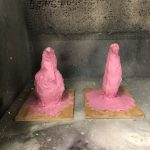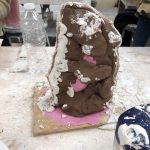
I had never worked with a process with as many steps as the two-part mould, but was very happy with the final casts that captured a high level of detail from the silicone mould. The silicone allows for several casts, unlike alginate.

Silicone mould:
- Choose an object. A hard object with good volume is ideal for a first mould.
- Fix object to a board, ideally using a screw.
- Prepare your work space with your object, silicone and gel, paintbrush, scraper, mixing stick (an ice-lolly stick or scrap piece of wood is ideal) and thickener.
- Add the silicone to the gel, mixing well.
- For 400ml silicone, add one cap of thickener. To get finer detail, make a thin layer without thickener and wait until it gets tacky, then add a thicker layer.
- Add clay to the base for a ticker pour spout. Liberally apply silicone to object.
- Smooth down using a scraper to make a relatively flat surface.
- Ensure all areas are covered, making one side slightly thicker than the rest.
- Leave for 24 hours to completely set and dry.
Mother mould:
- Mentally draw a line around the mould, splitting it in half while ensuring there are no steep curves. Draw this line using thick pieces of clay, reinforcing it on one side of the mould.
- Get the clay to be right angles to the silicone mould.
- Add indents so the other side of the mould has something else to hook onto.
- Using thicker made plaster, slap it on to get rid of any extra air bubbles.
- As it gets thicker, dome the shape of the plaster. The walls need to be thick to withstand several casts.
- Once one side it dry, take off all the clay. smooth the side of the plaster mould.
- Cover the wall and some of the outer cast in Vaseline. This ensures that the plaster will not stick to each other, creating the two sides of the mould.
- Complete the same plaster process on the other side, sans clay.
- Once both sides are dry, split the mould in half.
Silicone mould:
- Cut a zigzag pattern down the thickest part of the mould.
Casting:
- Put the silicone mould back into the mother mould, sliding the two halves of the mother mould together. Attach using thick sellotape, wrapped around the mould.
- Mix a thin plaster. Pour a small amount of plaster into the mould, swirl, pour it out. This picks up lots of detail that may otherwise be trapped.
- Repeat several times.
- Top up the mould with plaster and tap to get bubbles out.
- Leave to set.
- Once set and dry, cut open the sellotape and get out cast from the mould.
- Put the silicone and mother mould back together and repeat for number of casts desired.
Despite the long process, the final product was very appeasing. The high amount of detail that was picked up by the silicone mould was beautifully replicated in the cast produced. I was able to produce two casts from this mould, both of which came out wonderfully. There was some difficulty getting the silicone out of the mother mould the second time, however it was eased out. If I am able to in the future, I would like to explore the use of a repetitive process with moulds, and the impact of repetition.
















Leave a Reply